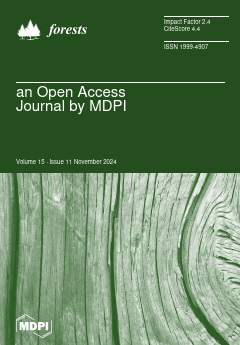Forest above-ground carbon stock (AGCS) is one of the primary ecological evaluation indicators, so it is crucial to estimate the AGCS accurately. In this research, we added the climatic and topographic factors to the estimation process by a remote sensing approach to explore their impact and to achieve more precise estimations. We hope to develop a more accurate estimation method for AGCS based on remote sensing data and climate data. The random forest (RF) method has good robustness and wide applicability. Therefore, we modeled and predicted the AGCS by RF based on sixty field sample plots of
Pinus densata pure forests in southwest China and the factors extracted from Landsat 8 OLI images (source I), Sentinel-2A images (source II), and combined Landsat 8 OLI and Sentinel-2A images (source III). We added the topographic and climatic factors to establish the AGCS estimation model and compared the results. The topographic factors contain elevation, slope, and aspect. Climatic factors contain mean annual temperature, annual precipitation, annual potential evapotranspiration, and monthly mean potential evapotranspiration. It was found that the R
2 and RMSE of the model based on source III were better than the R
2 and RMSE of the models based on source I and source II. Compared to the models based on source I and source II, the model based on source III improved R
2 by up to 0.08, reduced RMSE by up to 2.88 t/ha, and improved P by up to 4.29%. Among the models without adding factors, the model based on source III worked the best, with an
R2 of 0.87, an
RMSE of 10.81 t/ha, an
rRMSE of 23.19%, and a
P of 79.71%. Among the models that added topographic factors, the model based on source III worked best after adding elevation, with an
R2 of 0.89, an
RMSE of 10.01 t/ha, an
rRMSE of 21.47%, and a
P of 82.17%. Among the models that added climatic factors, the model that added the annual precipitation factor had the best modeling result, with an
R2 of 0.90, an
RMSE of 9.53 t/ha, an
rRMSE of 20.59%, and a
P of 83.00%. The prediction result exhibited that the AGCS of the
Pinus densata forest in 2021 was 9,737,487.52 t. The combination of Landsat 8 OLI and Sentinel-2A could improve the prediction accuracy of the AGCS. The addition of annual precipitation can effectively improve the accuracy of AGCS estimation. Higher resolution of climate data is needed to enhance the modeling in future work.
Full article





